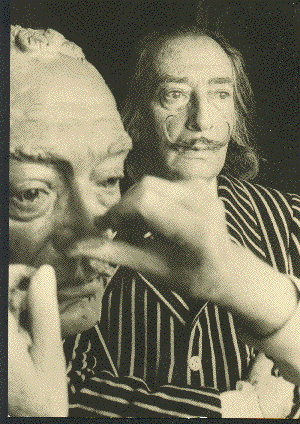
Salvador Dali posing for his friend Arno Breker.

Salvador Dali posing for his friend Arno Breker.
Salvador Dali had invited me in September, 1974, to participate in the opening of his museum in Figueras. He had asked me to lend him my marble bust of Jean Cocteau for the exhibition opening. I had brought it along and set it up in the museum immediately. On the day of the opening there was terrible weather; it rained in torrents. The opening festivities were to take place in the afternoon. Also rumors about assassination plots and hidden bombs were becoming public knowledge. Nevertheless, no one left the company of Dali. I had the good fortune of being able to stay inside the museum while others stood outside or whiled away the time in neighboring cafés.
At 9:00 o'clock p.m. the stage was all set. Dali made his entrance like a sovereign and was dressed accordingly. I had held back at first, and Dali was looking for my Cocteau bust. He had it set up elsewhere, since it was supposed to be illuminated with special lighting. In a large room, then, it was set up, splendidly draped. After his speech, he himself led the guests through the museum. And when we came to the room where the bust stood, he asked, "Where is Breker?" They looked for me, and I came to him. Dali's conversation turned to me. In front of the audience he strongly embraced and thanked me for having presented the Cocteau bust to the museum. So from one moment to the next my bust was taken from me. But Dali did it with so much charm that I was not able to say no.
Dali lives in Port Lligat in a scenically, exquisitely beautiful place. It is a blessed state of affairs when one is able to live and work in such divine surroundings. Also inspiring, it is of decisive importance because this characteristic landscape really pops up again and again in his pictures. Dali cannot, moreover, separate himself from the view he has from the terrace of his house in Port Lligat. Everything takes place in a giant unbounded space. The horizontal line terminates at the horizon, from it mountainous fragments jut forth. On the plain in front of it a drama is unfolding: people appear or remarkable animals are found; elephants on stilts. Such visions, with which Dali's fantasy is richly overflowing, are nurtured by the brooding, glowing sun of Spain.
One painting by Dali in the Museum impressed me immediately and deeply for a long time afterward: on the table there stands a breadbasket with a cut loaf of bread. From the thematic point of view this picture is sufficient for a timeless situation. It is deeply human and in its simplicity of greatest animation. This painting, which Dali painted in another variation and belongs to the collection of A. Reynolds Morse in St. Petersburg, Florida, shows his unerring feel for the most necessary, here the quintessence of life. I know in Dali's work no more convincing symbol of life than this piece of bread which comes alive right before us in the picture.
What I discovered first in Dali and what struck me is his similarity to Velasquez. From the standpoint of physiognomy, similarities exist which I wanted to make clear in my bust, above all the mouth, the nose and the moustache. Velasquez wears his normally, while Dali has stylized his into a symbol of himself which requires much attention and care daily. When I looked up Dali at his home, I found him on the terrace. His hair was fantastically arranged by the ever blowing wind of the sea. I had begun my bust, but then found the hair to be too massive in volume; it was not loose enough. Having returned home, I took up the problem of shaping the hair once again. So then I arranged the hair in groupings and loosened it up. The gentle play of the wind is retained this way. The abundance of hair and the method of shaping give Dali the appearance of a baroque prince, of a habitus , whom he surely wanted to symbolize. The abundance of possibilities in inner visions and painted images of Dali confirm this.
Dali's surrealistic paintings with their dream worlds are so convincingly composed that one cannot ignore them. And I come to Picasso who was his antithesis. It is a unique coincidence that in almost one generation from a particular region two such ingenious phenomena have come forth. Salvador Dali gave full rein to his prime gift and created a giant body of work of unusually impressive magnitude.
(1983)
An excerpt from the book Schriften by Arno Breker.
Translated from the German by Dr. Benjiman D. Webb.
Copyright C 1987 Edition MARCO/ABSI, 10545 Main Street, Clarence, New York 14031 (USA).
Arno Breker: His Art and Life, by B. John Zavrel
Collected Writings of Arno Breker, by Arno Breker
Living with the Himalayan Masters, by Swami Rama
Alexander the Great, by Robin Lane Fox
Primer for Those Who Would Govern, by Hermann Oberth